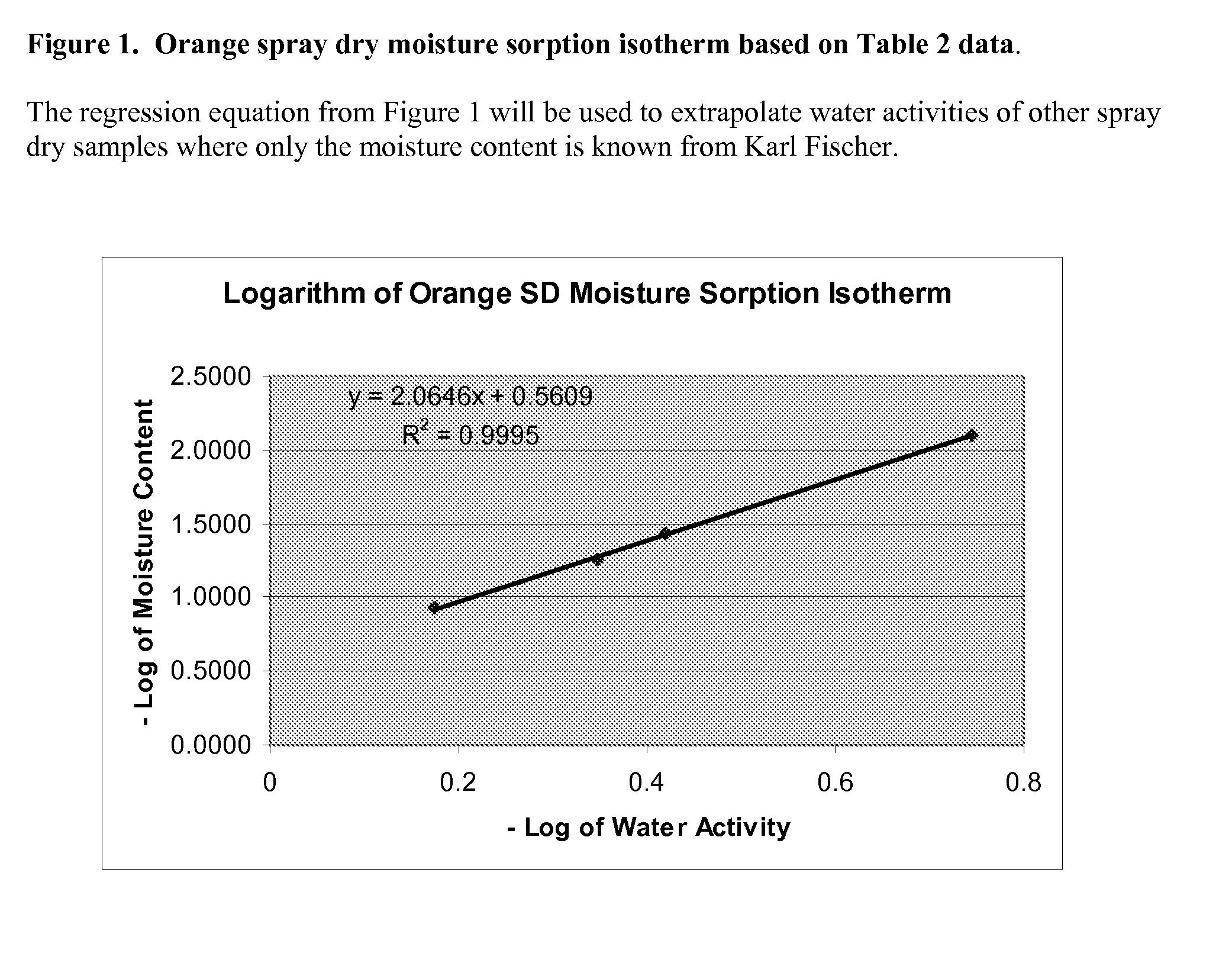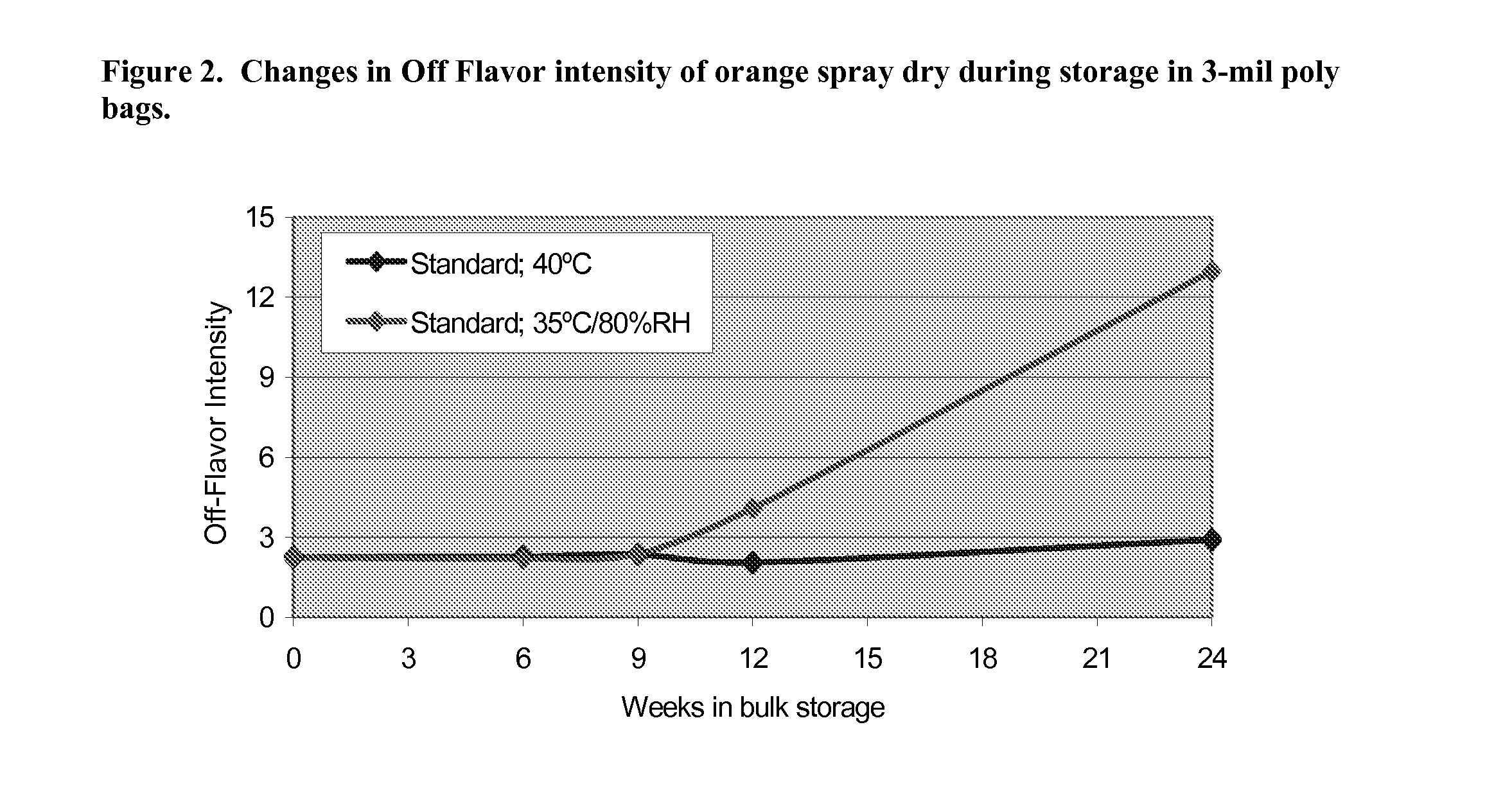Method of Producing a Shelf-Stable Citrus Spray-Dry Product
a technology of citrus and spray drying, applied in the field of storage-stable citrus flavor compositions, can solve the problems of low odor and flavor threshold, inability to produce fresh citrus, and inability to meet the needs of consumers, and achieve the effect of reducing relative humidity
- Summary
- Abstract
- Description
- Claims
- Application Information
AI Technical Summary
Benefits of technology
Problems solved by technology
Method used
Image
Examples
example 1
[0041]The spray-dried (SD) flavor used in this study contained a mixture of modified starch, sugar and single fold essential orange oil. On a dry weight basis (d.b.), this spray-dried flavor contained:
TABLE 1Spray dry formulaIngredients%Modified Starch60-70Sugar10-20Orange Oil20
[0042]This formula was chosen because it represents a commercial spray-dried flavor.
[0043]This product was made using standard spray dry processing techniques. First the starch and sugar were added to water (50-55° C.) and mixed until hydrated / dissolved. The temperature of the mixture was then decreased to approximately 30° C. before addition of the essential oil. Afterwards, the slurry was mixed for 20 minutes using an Arde-Barinco high shear mixer at a pressure of 60 psi in order to form an emulsion. The slurry was then fed into the spray dryer, a Niro Utility Model I with a centrifugal atomizer and a single point product collection. Dryer air temperatures were set to 380° F. (193° C.) at the inlet and 190°...
example 2
[0044]The following test was conducted to determine the relationship between moisture uptake and glass transition temperature. Exposure of the spray-dried (SD) flavor in an environment above its water activity (aw) will result in moisture uptake. Water activity equals relative humidity (RH) divided by 100; RH is a measure of the moisture in the environment, whereas, aw is a property of the food material.
[0045]The fresh SD (control) made in Example 1 was allowed to equilibrate at three different relative humidities before measuring their water activities using a Decagon AquaLab Model Series 3TE (Serial#799412) and their glass transition temperatures (Tg) using a TA Instruments Differential Scanning Calorimeter (DSC) Q1000. Tg measurements were taken as the inflection point in the slope of the heating curve. Prior to this test, the fresh spray dry was found to contain 0.8% moisture by Karl Fischer. For this test, saturated salt solutions of magnesium chloride, potassium carbonate and ...
example 3
[0048]The following test was conducted to determine if the flavor stability of an orange spray dry can be maintained at an elevated temperature (40° C.) for at least 12 weeks if kept in a low humidity environment (about 25% RH). Citrus-based spray-dried flavors usually develop off-flavors within 6 to 12 months of storage under recommended storage conditions (25° C., less than 50% RH) or 6-12 weeks at accelerated storage at 40° C.
[0049]The spray dry used in the following study is comprised of the same matrix as described in Example 1. In this spray-dried flavor, the encapsulated flavor comprised of a single fold essential orange oil with added topnotes for a more acceptable sensory profile. Samples of this spray dry were stored in either 3 mil polyethylene bags or vacuum sealed Mylar® bags (with and without nitrogen flush) at both 40° C. / 13% RH and 35° C. / 80% RH. Samples were also stored in vacuum sealed Mylar® bags and then sealed in a nitrogen flushed tin can at −84° C. to be used ...
PUM
 Login to View More
Login to View More Abstract
Description
Claims
Application Information
 Login to View More
Login to View More - R&D
- Intellectual Property
- Life Sciences
- Materials
- Tech Scout
- Unparalleled Data Quality
- Higher Quality Content
- 60% Fewer Hallucinations
Browse by: Latest US Patents, China's latest patents, Technical Efficacy Thesaurus, Application Domain, Technology Topic, Popular Technical Reports.
© 2025 PatSnap. All rights reserved.Legal|Privacy policy|Modern Slavery Act Transparency Statement|Sitemap|About US| Contact US: help@patsnap.com



